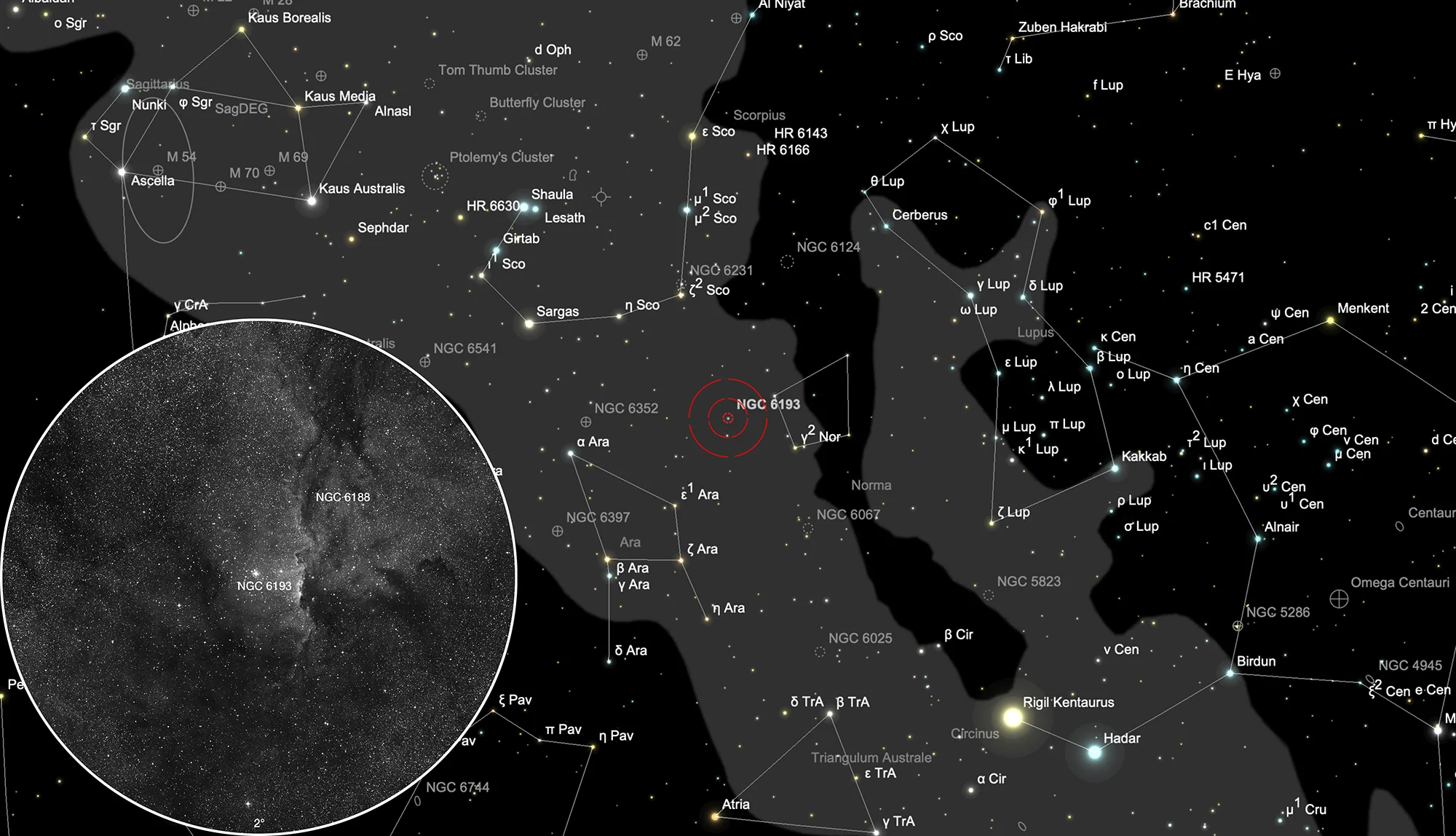Open Cluster NGC 6193 & Rim Nebula NGC 6188

History
The open cluster NGC 6193 was discovered by Scottish astronomer James Dunlop on 14 May 1826. He observed it using his selfmade 9-inch reflector from Paramatta NSW, Australia, made three observation and listed it as Δ 413 with the following notes: «A cluster of small stars, with a bright star in the preceding side. A very considerable branch or tail proceeds from the north side, which joins a very large cluster.» [50]
On 15 April 1836 (sweep 693) John Herschel observed this cluster with his 18.7-inch reflector from South Africa. He added two different entries. Entry h 3640 (NGC 6188): «The brightest part of a very large, faint, diffused, branching nebula, which involves in its northern following part the star B[risbane] 5789, and extends into the cluster Δ 413, which it in part surrounds. No doubht about the nebula, which in the brightest part of it precedes the cluster about 1 minute of time. The following stars behind the double star, and quite free of nebula. I presume the nebula and cluster to be unconnected.» Entry h 3642 (NGC 6193): «Cluster VIII class; consists of about a dozen stars 10..10 mag, and perhaps as many less, with stragglers, which fill field. In its preceding part is a fine double star (place as here set down), and yet more preceding is a very large, faint nebula, in which the preceding part of the cluster is involved.» [11]
Physical Properties
The open star cluster NGC 6193 contains around thirty bright stars and forming the heart of the Ara OB1 association, which is some 4000 light-years away from Earth. The two brightest stars are very hot giant stars. Together, they provide the main source of illumination for the nearby emission nebula, the Rim Nebula, or NGC 6188, which is located west of the cluster. OB associations are loose groups of young, massive, blue–white stars. The Rim Nebula marks the edge of a star-forming region within the hydrogen-rich molecular cloud RCW 108, known as an H II region. Radiation and stellar winds from NGC 6193 trigger new star formation in the surrounding gas and dust. As clouds collapse into stars, they are eroded by winds, radiation, and supernovae. Only about 10% of the material forms stars; the rest is expelled. The Rim Nebula shows early signs of «pillar formation», hinting it may evolve to resemble famous star-forming regions like the Eagle or Cone Nebulae. [737]
| Name | RA | Dec | Type | vMag | Dim | MD | Dreyer Description | Identification, Remarks |
|---|---|---|---|---|---|---|---|---|
| NGC 6188 | 16 40 05.0 | -48 39 42 | EN+RN | 20 × 12 | 1.200 | ! F, vL, viE, B * inv | h 3640; GC 4223; ESO 226-EN19 | |
| NGC 6193 | 16 41 20.3 | -48 45 48 | OCL (II3p) | 5.2 | 14 | 1.155 | Cl, vL, lRi, lC, rrr, F neb inv | h 3642; GC 4225; OCL 975; ESO 226-SC20; in N 6188 |
Finder Chart
The open cluster NGC 6193 with Nebula NGC 6188 is located in the constellation Ara. Unfortunately it is not visible from Europe. On 3 June it in opposition with the Sun and is therefore highest in the sky at local midnight.
